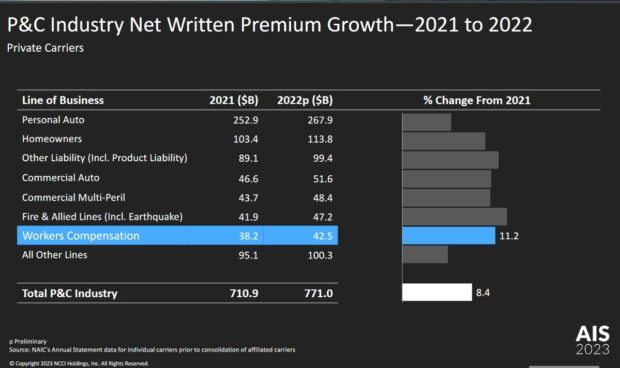Private carrier workers compensation premium continues to climb, according to an annual State of the Line Report released during NCCI’s Annual Insights Symposium (AIS) 2023 on May 9 in Orlando, Fla.
Premiums increased by 11 percent in 2022, returning to a similar level of premium attained in 2019, $47.5 billion.
The years spanning 2019 and 2002 saw a 1.1 percent premium growth in workers compensation, while direct written premiums for private carriers increased by 3.1 percent between 2019-2022.
Underwriting profitability continued for the ninth consecutive year, with a calendar year combined ratio of 84 in 2022.
The report noted it was the sixth consecutive year with a combined ratio of 90 or below for the line.

“Despite an unsettled environment over the past few years, the reality is that workers compensation has had more tailwinds than headwinds influencing results,” said Bill Donnell, president and CEO of NCCI. “Experience tells us that it won’t last forever, and we must be ready.”
Lost-time claim frequency returned to its 20-year trend, declining 4 percent in the past year.
A rise in severity for 2022 was noted by NCCI, with medical claim severity increasing nearly 5 percent and indemnity claim severity rising 6 percent year over year (excluding COVID-19 claims). The longer-term perspective suggests this is a manageable rise.
Claim frequency decreased by 4 percent. Claim frequency by injury during 2019-2021 accident years revealed increases in injuries involving caught in between and burned, rubbed or abraded.
Loss costs decreases are being impacted by payroll increases resulting from employment and wage increases growing faster than claims costs, said Dan Benzshawel, executive director and actuary for the NCCI.
“There’s two main dynamics at play,” he added. “First, frequency is declining. Second, wages are outpacing average claim costs. Frequency remains the main cost driver in the workers comp system.”
In addition, workplace safety improvement and the increased use of automation aided in reducing the frequency of claims.
Long-term frequency declines are expected to continue, said Carolyn Wise, manager and associate actuary.
The accident year combined ratio is 97, with NCCI reporting that prior years continue to experience downward reserve development.
Workers compensation reserve redundancy grew to $17 billion.
Analysis of COVID-19’s impact for accident years 2020-2022 by the NCCI revealed $628 million in losses, 118,000 claims with an average severity of $5300.
“Overall, you see a healthy and strong workers compensation system,” NCCI Chief Actuary Donna Glenn added. “Workers compensation premium is up by 11 percent, which has essentially made up the ground that was lost during the pandemic.”





















 NOAA Announces Latest AI-Driven Global Weather Models
NOAA Announces Latest AI-Driven Global Weather Models  Carrier Management’s 2025 Top Features (Reader’s Picks Unlocked)
Carrier Management’s 2025 Top Features (Reader’s Picks Unlocked)  Berkshire Hathaway Enters Post-Buffett Era as Share Prices Fall
Berkshire Hathaway Enters Post-Buffett Era as Share Prices Fall  Good Times for U.S. P/C Insurers May Not Last; Auto Challenges Ahead
Good Times for U.S. P/C Insurers May Not Last; Auto Challenges Ahead 